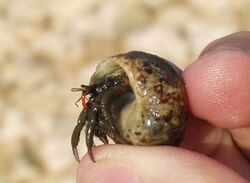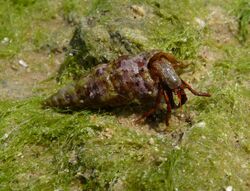Biology:Clibanarius erythropus
| Clibanarius erythropus | |
|---|---|

| |
| Scientific classification | |
| Domain: | Eukaryota |
| Kingdom: | Animalia |
| Phylum: | Arthropoda |
| Class: | Malacostraca |
| Order: | Decapoda |
| Suborder: | Pleocyemata |
| Infraorder: | Anomura |
| Family: | Diogenidae |
| Genus: | Clibanarius |
| Species: | C. erythropus
|
| Binomial name | |
| Clibanarius erythropus (Latreille, 1818) [1]
| |
| Synonyms [1] | |
| |
Clibanarius erythropus is a species of hermit crab that lives in rockpools and sublittoral waters.[2] It is found in the Mediterranean Sea, Black Sea and eastern Atlantic Ocean from the Azores to Brittany, the Channel Islands and as far north as the south Cornwall coast.[2][3][4] Individuals may grow up to a carapace length of 15 millimetres (0.6 in).[2]
Ecology
A variety of different gastropod shells are used by C. erythropus, the most frequent being Littorina striata, Mitra, Nassarius incrassatus and Stramonita haemastoma, which collectively account for 85% of all the individuals studied in the Azores;[5] in the Mediterranean, shells of Cerithium, Alvania montagui and Pisania maculosa are most used by C. erythropus.[6]
Like other hermit crabs, C. erythropus feeds on "organic debris, decayed and fresh macro-algae with associated fauna and epiphytic algal flora, small invertebrates, and macroscopic pieces of dead and live animal tissues".[3] It has been shown that C. erythropus individuals select substrates where they can cover large distances, and that globose shells allow them greater mobility than elongate ones.[3]
In popular culture
In 2016 the BBC Springwatch programme highlighted C. erythropus and ran a competition to provide a vernacular name. The winning name was St Piran's crab, a process supported by National Trust West Cornwall and the Cornwall Wildlife Trust. Saint Piran is generally regarded as the patron saint of Cornwall, and was a hermit who survived being thrown into the sea.[7][4]
References
- ↑ Jump up to: 1.0 1.1 Michael Türkay (2009). "Clibanarius erythropus (Latreille, 1818)". in Patsy McLaughlin. World Paguroidea database. World Register of Marine Species. http://www.marinespecies.org/aphia.php?p=taxdetails&id=107196. Retrieved 8 June 2010.
- ↑ Jump up to: 2.0 2.1 2.2 E. Wilson (2005). "A hermit crab — Clibanarius erythropus". Marine Life Information Network. http://www.marlin.ac.uk/species/Clibanariuserythropus.htm.
- ↑ Jump up to: 3.0 3.1 3.2 Chiara Benvenuto, Gianfranco Sartoni and Francesca Gherardi (2003). "Foraging behaviour of the hermit crab Clibanarius erythropus in a Mediterranean shore". Journal of the Marine Biological Association of the United Kingdom 83 (3): 457–461. doi:10.1017/S0025315403007331h.
- ↑ Jump up to: 4.0 4.1 "Rare hermit crab rediscovered". http://www.cornwallwildlifetrust.org.uk/news/2016/03/16/rare-hermit-crab-rediscovered. Retrieved 16 March 2016.
- ↑ Andrea Z. Botelho & Ana C. Costa (2000). "Shell occupancy of the intertidal hermit crab Clibanarius erythropus (Decapoda, Diogenidae) on São Miguel (Azores)". Hydrobiologia 440 (1/3): 111–117. doi:10.1023/A:1004190220509.
- ↑ Chiara Benvenuto & Francesca Gherardi (2001). "Population structure and shell use in the hermit crab, Clibanarius erythropus: a comparison between Mediterranean and Atlantic shores". Journal of the Marine Biological Association of the United Kingdom 81 (1): 77–84. doi:10.1017/S0025315401003423.
- ↑ http://ntwestcornwall.co.uk/?p=2292 the Incredible Life of a Rockpool
Wikidata ☰ Q3680644 entry
 |


